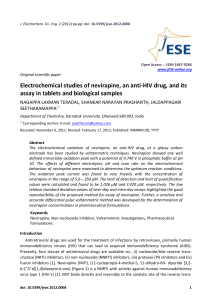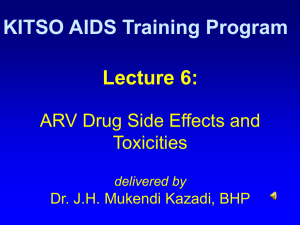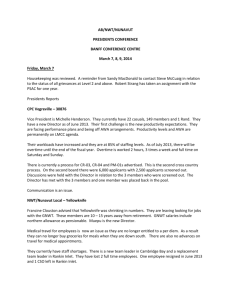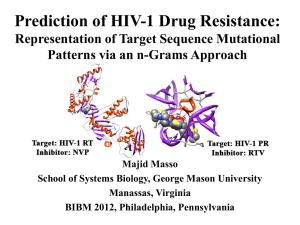jESE_Vol2_No2_p67
advertisement
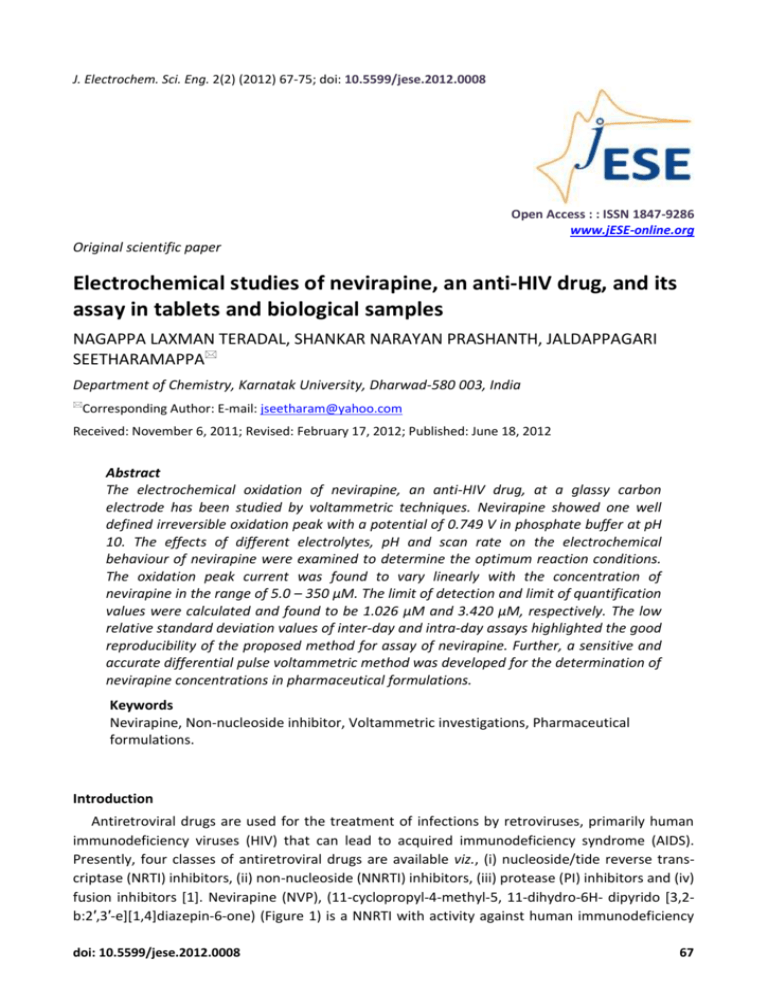
J. Electrochem. Sci. Eng. 2(2) (2012) 67-75; doi: 10.5599/jese.2012.0008 Open Access : : ISSN 1847-9286 www.jESE-online.org Original scientific paper Electrochemical studies of nevirapine, an anti-HIV drug, and its assay in tablets and biological samples NAGAPPA LAXMAN TERADAL, SHANKAR NARAYAN PRASHANTH, JALDAPPAGARI SEETHARAMAPPA Department of Chemistry, Karnatak University, Dharwad-580 003, India Corresponding Author: E-mail: jseetharam@yahoo.com Received: November 6, 2011; Revised: February 17, 2012; Published: June 18, 2012 Abstract The electrochemical oxidation of nevirapine, an anti-HIV drug, at a glassy carbon electrode has been studied by voltammetric techniques. Nevirapine showed one well defined irreversible oxidation peak with a potential of 0.749 V in phosphate buffer at pH 10. The effects of different electrolytes, pH and scan rate on the electrochemical behaviour of nevirapine were examined to determine the optimum reaction conditions. The oxidation peak current was found to vary linearly with the concentration of nevirapine in the range of 5.0 – 350 µM. The limit of detection and limit of quantification values were calculated and found to be 1.026 µM and 3.420 µM, respectively. The low relative standard deviation values of inter-day and intra-day assays highlighted the good reproducibility of the proposed method for assay of nevirapine. Further, a sensitive and accurate differential pulse voltammetric method was developed for the determination of nevirapine concentrations in pharmaceutical formulations. Keywords Nevirapine, Non-nucleoside inhibitor, Voltammetric investigations, Pharmaceutical formulations. Introduction Antiretroviral drugs are used for the treatment of infections by retroviruses, primarily human immunodeficiency viruses (HIV) that can lead to acquired immunodeficiency syndrome (AIDS). Presently, four classes of antiretroviral drugs are available viz., (i) nucleoside/tide reverse transcriptase (NRTI) inhibitors, (ii) non-nucleoside (NNRTI) inhibitors, (iii) protease (PI) inhibitors and (iv) fusion inhibitors [1]. Nevirapine (NVP), (11-cyclopropyl-4-methyl-5, 11-dihydro-6H- dipyrido [3,2b:2′,3′-e][1,4]diazepin-6-one) (Figure 1) is a NNRTI with activity against human immunodeficiency doi: 10.5599/jese.2012.0008 67 J. Electrochem. Sci. Eng. 2(2) (2012) 67-75 ELECTROCHEMICAL STUDIES OF AN ANTI-HIV DRUG virus type 1 (HIV-1) [2]. NVP binds directly and reversibly to the catalytic site of the reverse transcriptase enzyme, and therefore interferes with viral RNA to DNA-directed polymerase activities [3]. It is recommended for treating HIV infections in combination with other reverse transcriptase inhibitors such as stavudine and lamivudine [4-7]. Figure 1. Structure of nevirapine Electrochemical methods have proven to be sensitive and reliable for the determination of numerous electroactive compounds [8-10]. Under some circumstances, electrochemical methods can offer optimal solutions for drug analysis. Simplicity, low cost and relatively short analysis times make electrochemical techniques more useful for routine analytical applications. A literature survey reveals that no attempt has been made up to the present date to investigate the electrochemical behavior of NVP, and determine it in pharmaceutical formulations by voltammetric methods. A few chromatographic methods viz., HPLC, LC-MS or LC-MS/MS have been reported for the determination of NVP [11-16]. These methods require long analysis times, elaborate extraction and purification steps, or on-line sample extraction, and are relatively costly. Hence, the aim of the present work is to develop a simple, sensitive and accurate electrochemical method for the analysis of NVP, in bulk and dosage forms. The proposed method is more sensitive compared to reported methods [11,12]. Experimental Reagents and Solution Preparations A stock solution of NVP (2.5 mM) was prepared in methanol - water (20:80, v/v) and stored in a refrigerator at 4 °C. Working solutions of the drug were prepared daily by diluting the stock solution with the selected supporting electrolyte. In the present study, two different buffers viz., Britton Robinson buffer (pH 2 - 10) and phosphate buffer (pH 3 - 10.6) were used as the supporting electrolytes. All other chemicals used in this investigation were of analytical grade. Apparatus and procedure Electrochemical studies were carried out on a CHI-1110a Electrochemical Analyser (CH Instruments Ltd. Co., USA, version 4.01) electrode system consisting of a glassy carbon electrode (GCE) (3 mm diameter) as the working electrode, a platinum wire as the counter electrode and an Ag/AgCl reference electrode. pH measurements were made on a EQ-610 pH meter (EquipTronics, India). The GCE was polished using 0.3 micron Al2O3 before each measurement. After polishing, the electrode was rinsed thoroughly with water and then used for analysis. 68 N. L. Teradal et al. J. Electrochem. Sci. Eng. 2(2) (2012) 67-75 The parameters for differential pulse voltammetry (DPV) were: pulse amplitude - 50 mV; pulse width - 30 ms; and scan rate - 20 mV s-1 maintained. Assay of tablets Tablets of NVP (each containing 200 mg of NVP) were obtained from local commercial sources. Ten tablets were finely powdered, and a portion of this powder equivalent to 2.5 mM of NVP was weighed and transferred into a 25 mL calibrated flask containing a methanol-water mixture (20:80, v/v). It was then sonicated for 15 min to effect complete dissolution, and diluted to volume with the same solvent. Suitable amounts of this solution were taken and analyzed. The amount of NVP in the tablet was calculated using a calibration graph or regression equation. Determination of NVP in human urine and plasma samples A spiked urine sample was obtained by treating a 1.8 ml aliquot of urine with 200 μl of NVP solution (2.5 mM). A suitable aliquot of the spiked urine was then diluted with phosphate buffer without any pre-treatment to prepare appropriate sample solutions, and their differential pulse voltammograms were recorded under optimized conditions. For the determination of NVP in plasma, spiked serum samples were prepared following the procedure reported earlier [17]. Serum samples obtained from healthy individuals (after obtaining their written consent) were stored frozen until assay. For the assay of NVP in plasma, 1 ml of NVP solution (5 mM) was added to 1 ml of untreated plasma. The mixture was vortexed for 30 s. In order to precipitate the plasma proteins, the plasma samples were treated with 500 µl of 15% HClO4. Afterward, the mixture was vortexed for 30 s and then centrifuged at 5000 rpm for 5 min. An appropriate volume of supernatant liquor was transferred to a voltammetric cell containing phosphate buffer at pH 10, and voltammograms were recorded. The voltammograms of blank samples (without NVP) did not show any signal that could interfere with this direct determination. The content of the drug in plasma was determined by referring to a calibration graph or regression equation. Results and Discussion Voltammetric behavior of NVP at a GCE The electrochemical behavior of NVP at a GCE was investigated by CV. NVP showed one oxidation peak at 0.749 V in phosphate buffer at pH 10 with a scan rate of 100 mV s-1 (Figure 2). No peak was observed in the reverse scan, suggesting that the oxidation of NVP on the GCE was irreversible. Multi-sweep cyclic voltammograms of NVP (data not shown) revealed a significant decrease in peak current, indicating fouling of the electrode surface due to adsorption of NVP or its oxidation product. Effect of different electrolytes and pH on electrooxidation of NVP The influence of pH on the peak current (ip) and peak potential (Ep) was investigated in phosphate (pH 3.0 – 10.6) and BR (pH 2 – 12) buffers. In both buffers, the oxidation peak current of NVP decreased in the pH range of 3 – 7 (data not shown). Above pH 7, the peak current increased up to pH 10.6 (Figure 3). Furthermore, a sharper, well defined peak was noted in phosphate buffer at pH 10; hence, we have used this buffer throughout the study. doi: 10.5599/jese.2012.008 69 J. Electrochem. Sci. Eng. 2(2) (2012) 67-75 ELECTROCHEMICAL STUDIES OF AN ANTI-HIV DRUG Current, µA a b Potential, V vs. Ag/AgCl 1.4 6 1.2 5 1 4 0.8 3 0.6 2 0.4 1 Ep / V 7 Ep/V ipip/ /mA µA Figure 2. Cyclic voltammogram of a) 50 µM NVP in phosphate buffer at pH 10 and b) blank (buffer solution). 0.2 2 4 6 pH pH 8 10 12 Figure 3. Effect of pH on peak potential (■) and peak current (▲) for 50 µM NVP Figure 3 shows the effect of pH on peak potential (■) and peak current (▲) of 50 µM NVP in phosphate buffer. The peak current of NVP was observed to be maximal at pH values between 8 and 10. This might be attributed to the deprotonation of radical cations in the basic medium, leading to the formation of radical species. This in turn facilitated the oxidation of NVP. This was less pronounced at pH values 7 and 9; hence, the peak heights were found to be minimal. The 70 N. L. Teradal et al. J. Electrochem. Sci. Eng. 2(2) (2012) 67-75 anodic peak potential of NVP was shifted towards less positive potential with increasing pH of the buffer. This revealed that the pH of the supporting electrolyte exerted a significant influence on electrooxidation of NVP on the GCE, and involvement of a proton in the oxidation process. The plot of peak potential versus pH gave a slope of 63.8 mV pH-1, which is close to the expected value of 59 mV pH-1 for participation of equal numbers of protons and electrons in the NVP oxidation process [18–21]. The corresponding equation is shown below: Ep = 1.403 – 0.0638 pH: r2 = 0.991. Further, the number of electrons transferred, n, was determined by the peak width, W1/2 at half height. This was found to be around 83 mV in all the electrolytes, which is close to the theoretical value of 90 mV expected for an electrochemical reaction involving transfer of a single electron [22]. Hence, we propose the electroxidation of NVP involves the transfer of one electron. Based on the above results, a probable mechanism for electrooxidation of NVP is proposed (Scheme 1). It is proposed that the secondary ring nitrogen of NVP undergoes a single electron oxidation to yield a radical cation, which is further deprotonated to form a radical. Then, the free radical readily combines with another radical to form a dimerized product. This scheme is also in agreement with an earlier report [23]. + -H Scheme 1. Probable reaction mechanism for electrooxidation of NVP. Influence of scan rate on electrooxidation of NVP We examined the influence of the scan rate on the electrochemical behavior of NVP, to understand the nature of the electrode process. For this, we recorded cyclic voltammograms of 50 µM NVP at a GCE at different scan rates (Figure 4). The oxidation peak current of NVP was noted to increase with increasing scan rate, with a positive shift in the peak potential. The plot of values of log ip versus log ν in the scan rate range of 10–350 mV s-1 yielded a straight line with a slope of 0.57. This value is close to the theoretical value of 0.5 expected for an ideal reaction condition for a diffusion-controlled electrode process [24]. doi: 10.5599/jese.2012.008 71 ELECTROCHEMICAL STUDIES OF AN ANTI-HIV DRUG Current, µA J. Electrochem. Sci. Eng. 2(2) (2012) 67-75 Potential, V vs. Ag/AgCl Figure 4. Cyclic voltammograms for the oxidation of NVP at different scan rates (1–12): 10, 20, 40, 60, 80, 100, 120, 140, 180, 220 and 260, 300, 350 mV s−1. Analytical applications Calibration curve Considering the electrochemical oxidation of NVP at a GCE, an analytical method was developed using DPV. Differential pulse voltammograms of NVP at different concentrations are shown in Figure 5. Under the optimized conditions, a linear relationship between the peak current and drug concentration was observed in the range of 5.0 – 350 µM (Table 1). Above a concentration of 350 µM, linearity was lost, probably due to adsorption of NVP on the electrode surface. Validation of the optimized procedure for quantitative assay of NVP was examined via evaluation of LOD, LOQ, accuracy, precision and recovery values. The LOD and LOQ values were calculated using the equation below [25]: LOD= 3 s / m, LOQ= 10 s / m where s is the standard deviation of the peak currents (five runs), and m is the slope of the calibration curve. The LOD and LOQ values were found to be 1.026 µM and 3.420 µM, respectively (Table 1). Low values of LOD and LOQ confirmed the sensitivity of the proposed method. The interday reproducibility of the method was examined by recording the voltammograms of six replicates at 150, 200 and 250 µM. These yielded RSD values of 2.65, 2.50 and 2.24 %, respectively. Further, the RSD values for intra-day assay reproducibility in 150, 200 and 250 µM solutions (n = 6) were found to be 2.33, 2.28 and 2.97 %. The corresponding results are shown in Table 1. The low values of RSD confirm the good precision of the proposed DPV method for assaying NVP. The major advantages of the proposed method are its simplicity, ease of performance, and sufficient sensitivity for NVP. 72 J. Electrochem. Sci. Eng. 2(2) (2012) 67-75 Current, µA N. L. Teradal et al. Potential, V vs. Ag/AgCl Figure 5. Differential pulse voltammograms for increasing concentrations of NVP in phosphate buffer at pH 10 at a GCE. Scan rate: 10 mV s-1; pulse amplitude: 50 mV; and pulse width: 30 ms. NVP concentration was maintained at (1) 5.0, (2) 10, (3) 50, (4) 100, (5) 150, (6) 200, (7) 250, (8) 300, (9) 350 µM. Table 1. Characteristics of the calibration plot for NVP. Linearity range, µM LOD, µM DPV 5.0 - 350 1.026 LOQ, µM 3.420 Inter-day assay RSD* , % 2.65 Intra-day assay RSD*, % 2.97 * For 50 µM NVP Determination of NVP in urine and blood samples The proposed method was applied to the determination of NVP in spiked urine samples of healthy volunteers, but not to urine samples of patients treated with NVP. The recoveries from the urine samples were measured by spiking drug free urine with known amounts of NVP, and differential pulse voltammograms were then recorded. The amounts of NVP in the spiked urine samples were then evaluated from the calibration graph. The results of the analysis are listed in Table 2. The average recovery values, higher than 98.94 %, and RSD values less than 2.57 %, indicate the high accuracy and precision of the proposed method. Further, the proposed method was also applied to the assay of NVP in spiked human serum samples of healthy volunteers, but not to patient serum samples. For this experiment, drug free serum samples were spiked with 150, 200 or 250 µM of NVP; differential pulse voltammograms were then recorded. The amount of NVP in each serum sample was calculated from the calibration plot. The results of the analysis are summarized in Table 2. The percent recovery of NVP was determined by doi: 10.5599/jese.2012.008 73 J. Electrochem. Sci. Eng. 2(2) (2012) 67-75 ELECTROCHEMICAL STUDIES OF AN ANTI-HIV DRUG comparing the peak currents of the drug in serum samples with those of pure drug using the calibration curve. Table 2. Results of analysis of NVP in spiked human urine and serum samples. Urine samples NVP added, µM 150 200 250 Serum samples 150 200 250 n 5 5 5 Amount found, µM 148.90 197.89 249.78 Average recovery, % 99.26 98.94 99.91 RSD, % 2.57 2.45 2.25 5 5 5 149.96 198.02 248.91 99.97 99.01 99.56 2.31 2.28 2.07 Analysis of NVP in tablets The practical analytical application of the DPV method was further established by determining NVP concentrations in tablets. The corresponding results of the analysis are shown in Table 3. The low RSD values again highlighted the reproducibility of the results. Recovery studies were carried out using a standard addition method. Known quantities of pure NVP were mixed with defined amounts of pre-analyzed formulations; then the mixtures were analyzed as before. The total amount of the drug was then determined, and the amount of drug added was calculated by the difference. The high percentage of recovery indicates that the commonly encountered excipients in the formulation did not interfere with the proposed method. Table 3. Determination of NVP in tablets. Labeled amount, mg Amount found, mg Recovery, % RSD,c% Pure NVP added to tablet solution, mg Found, mg Recovery, % RSD, % a Nevimunea 200 198.7 99.35 1. 95 25 25.06 100.1 1.89 Neviretrob 200 199.8 99.90 1. 80 25 24.92 99.7 2.05 Marketed by Cipla. Ltd., India; bMarketed by Alkem (Cytomed) Ltd., India; cAverage of six determinations Conclusions In the present study, the electrochemical behavior of NVP at a GCE was investigated, and various electrochemical parameters are reported for the first time. Electrochemical oxidation of NVP was observed to be irreversible, diffusion controlled and pH dependent. Based on these findings, a simple, rapid and sensitive DPV method was developed for assaying NVP in pharmaceutical formulations and biological samples. Acknowledgements: We are grateful to the authorities of Karnataka University, Dharwad, for providing the necessary facilities. 74 N. L. Teradal et al. J. Electrochem. Sci. Eng. 2(2) (2012) 67-75 References [1] R.N. Rao, D.D. Shinde, J. Pharm. Biomed. Anal. 50 (2009) 994-999. [2] Indian Pharmacopoeia 1996: Addendum 2002. New Delhi: The controller of publications; (2002) 919 - 921. [3] J.C. Adkins, S. Noble, Drugs 56 (1998) 1055-1064. [4] D. Rey, M. Partisani, G. Hess-Kempf, V. Krantz, M. Priester, C. Cheneau, C. Bernard-Henry, E de Mautort, L. Decroix, J.M. Lang, J. Acq. Immun. Def. Synd. 37 (2004) 1454-1456. [5] C.C.J. Carpenter, M.A. Fischl, S.M. Hammer, M.H. Hirsch, D.M. Jacobsen, D.A. Katzenstein, J.S.G. Montaner, D.D. Richman, M.S. Saag, R.T. Schooley, M.A. Thompson, S. Vella, P.G. Yeni, P.A. Volberding, J. Amer. Med. Assoc. 277 (1997) 1962-1969. [6] R.M. Gulick, J.M. Mellors, D. Havlir, J.J. Eron, C. Gonzalez, D. McMahon, D.D. Richman, F. T. Valentine, L. Jonas,A. Meibohm, E. A. Emini, J. A. Chodakwitz, New Engl. J. Med. 337 (1997) 734-739. [7] W. Cavert, D.W. Notermans, K. Staskus, S.W. Wietgrefe, M. Zupancic, K. Gebhard, K. Henry, Z.Q. Zhang, R. Mills, H. McDade, C.M. Schuwirth, J. Goudsmit, S.A. Danner, A.T. Haase, Science 276 (1997) 960. [8] V.K. Gupta, R. Jain, K. Radhapyari, N. Jadon, S. Agarwal, Anal. Biochem. 408 (2011) 179– 196. [9] B. Uslu, S.A. Ozkan, Anal. Lett. 40 (2007) 817-853. [10] B. Uslu, S.A. Ozkan, Comb. Chem. High T. Scr. 10 (2007) 495-513. [11] M.S.M. Ahmed, J.S. Reddy, I.E. Chakravarth, K. Prabhavathi, J. Chem. Pharm. Res. 3(4) (2011) 172-176. [12] L.A. Zanolli Filho, C.R. Galdez, C.A. Silva, M.F.M. Tavares, D.M. Costa, M.S.A. Prado, J. Brazil. Chem. Soc. 22 (2011) 2005-2012. [13] H.N.Mistri, A.G.Jangid, A. Pudage, N. Gomes, M. Sanyal, P. Shrivastav, J. Chromatogr. B 853 (2007) 320-332. [14] G. Ramachandran, A.K. Hemanthkumar, V. Kumaraswami, S. Swaminathan, J. Chromatogr. B 843 (2006) 339-344. [15] H.N.Mistri, P. Shrivastav, A.G.Jangid, M. Sanyal, Anal. Lett. 40 (2007) 1147-1165. [16] P. Lemmer, S. Schneider, M. Schuman, C. Omes, V. Arendt, J.C. Tayari, L. Fundira, R. Wennig, Ther. Drug Monit. 27 (2005) 521-525. [17] P. Daneshgar, P. Norouzi, M.R. Ganjali, A.O. Seyedler, H. Eshraghi, Colloid Surface B 68 (2009) 27-32. [18] Y. Zhou, J. Zhi, X. Zhang, M. Xu, Diam. Relat. Mater. 20 (2011) 18-22. [19] P. Janeiro, A.M.O. Brett, Anal. Chim. Acta 518 (2004) 109-115. [20] I. Rebelo, J.A.P. Piedade, A.M.O.Brett, Bioelectrochemistry 63 (2004) 267-270. [21] R.N. Goyal, N. Bachheti, A. Tyagi, A.K. Pandey, Anal. Chim. Acta 605 (2007) 34-40. [22] C.M.A. Brett, A.M.O. Brett, Electrochemistry: Principles, Methods and Aplications, Oxford Science University Publications, Oxford 1993. [23] S.S. Kalanur, J. Seetharamappa, Anal. Lett. 43 (2010) 618-630. [24] A.J. Bard, L.R. Faulkner, Electrochemical Methods: Fundamentals and Applications, Wiley, New York, 1980. [25] S. Skrzypek, W. Ciesielski, A. Sokolowski, S. Yilmaz, D.Kazmierczak, Talanta 66 (2005) 11461151. © 2012 by the authors; licensee IAPC, Zagreb, Croatia. This article is an open-access article distributed under the terms and conditions of the Creative Commons Attribution license (http://creativecommons.org/licenses/by/3.0/) doi: 10.5599/jese.2012.008 75


